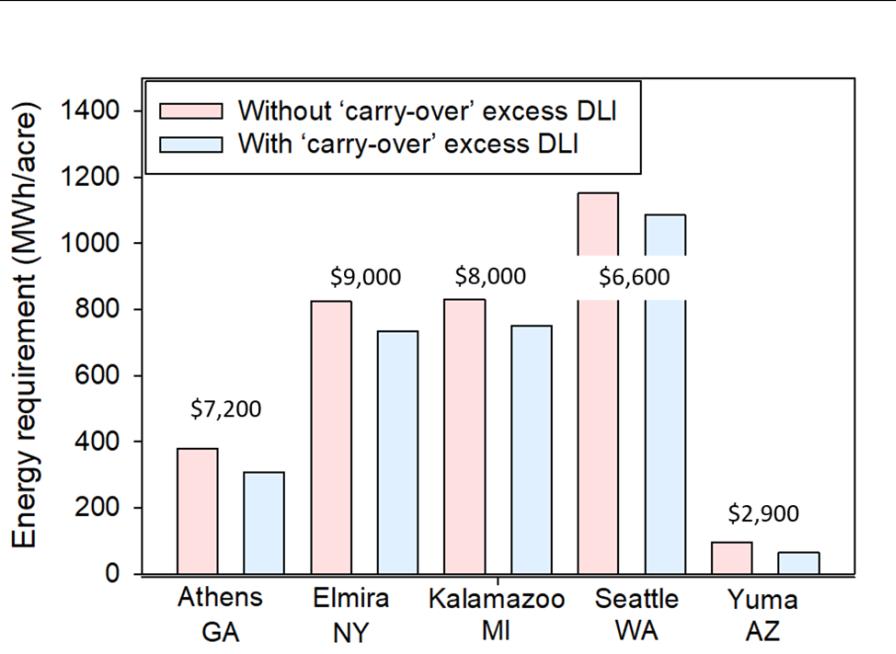How To Convert Sunny Days to Energy Savings in the Greenhouse
The electricity costs associated with supplemental lighting are high, which means good control over providing this supplemental light in the greenhouse can make the difference between profits and losses. Finding better supplemental lighting strategies can reduce costs and increase profitability in greenhouses.
To potentially lower lighting costs, our team at the University of Georgia asked a simple question: if the crop receives more light than the required daily light integral (DLI) one day, can we lower the DLI target for the following day? Our research suggests that this is indeed possible without compromising normal crop growth. Implementing this strategy can save thousands of dollars per acre per year.
What We Did
‘Green Salad Bowl’ and ‘Red Salad Bowl’ lettuce plants were grown under different light regimes in a growth chamber. In each lighting treatment, days with a high DLI alternated with days with a low DLI (15/15, 17.5/12.5, 20/10, 22.5/7.5, 25/5, and 27.5/2.5 mol‧m-2·d-1). All plants received the same average DLI, but the magnitude of day-to-day DLI fluctuations ranged from 0 to 25 mol‧m-2·d-1.
We subsequently did a similar study in the greenhouse with ‘Green Salad Bowl’ lettuce, again alternating days with high and low DLI: 15/15, 16.75/13.25, 18.5/11.5, 20.25/9.75, and 22/8 mol‧m-2·d-1 . In the greenhouse study, the DLI fluctuations were between 0 and 14 mol‧m-2·d-1. In both the growth chamber and greenhouse, the average DLI was 15 mol‧m-2·d-1.

FIGURE 1: ‘Green Salad Bowl’ (pictured) and ‘Red Salad Bowl’ lettuce plants were grown under different light regimes in a growth chamber.
Photo courtesy of Marc van Iersel
What We Found
In the growth chamber study, plants had similar dry weight and leaf area when grown with DLI fluctuations from 0 to 15 mol‧m-2·d-1 (15/15 to 22.5/7.5 mol‧m-2·d-1). Higher DLI fluctuations reduced plant growth. In the greenhouse study, DLI fluctuations from 0 to 10.5 mol‧m-2·d-1 all resulted in similar growth, while higher DLI fluctuations reduced growth (Figures 1, 2). Thus, following a sunny day in the greenhouse, the DLI crops can tolerate lower DLI levels.

FIGURE 2; Representative plants from the greenhouse study with ‘Green Salad Bowl’ lettuce. Growth was similar under most lighting treatments, but was reduced with day-to-day fluctuations in DLI of 14 mol‧m-2·d-1.
Photo by Marc van Iersel
Based on our findings, we recommend carrying over up to 5 -7 mol‧m-2·d-1 of light from a sunny to an overcast day. So, after a sunny day (DLI of 20 mol‧m-2·d-1 or higher), the target DLI can be reduced by 5 to 7 mol‧m-2·d-1 on the following day, without affecting growth. So far, we have only tested this approach with lettuce, but this likely will work in other crops as well.
Also important to keep in mind is that we alternated between high and low DLI every single day. In a real-world setting, it would be very unlikely that sunny and cloudy days would alternate throughout the entire cropping cycle. Days with higher than required DLI would likely occur much less frequently, and any growth impacts of carrying over that excess DLI would likely be even smaller than in our study. We conclude that this is a low-risk approach to reduce energy use and costs.
Why Does This Matter?
We used historical weather data from different U.S. locations to estimate energy and financial savings that can be achieved by carrying over the extra light sunny days provide to the following day. We assumed a target DLI of 17 mol‧m-2·d-1, a greenhouse light transmission of 70%, a light fixture efficacy of 1.8 µmol/J (typical for a good double-ended HPS light), and an electricity price of $0.10/kWh. The maximum excess DLI carried over from a sunny to an overcast day was 7.5 mol‧m-2·d-1.
Although we choose locations with very different weather, the cost savings that can be realized are similar in four of the five locations (Georgia, Michigan, New York, and Washington), ranging from $6,600 to $9,000 per acre per year. Only in Arizona did we see much lower energy savings, but that has little practical relevance; it is unlikely that an Arizona greenhouse would use supplemental lighting for a crop that requires a DLI of 15 mol‧m-2·d-1.

Annual energy use for supplemental lighting in five U.S. locations, with or without carrying over excess DLI from sunny days. Dollar figures indicate estimated savings that can be realized by carrying over excess DLI.
Take-Home Messages
Following a sunny day, the target DLI can be lowered the next day. This reduces energy use and costs without a negative impact on growth. So far, this has only been tested with lettuce, but likely works with most greenhouse crops. That said, we recommend testing this approach on a small scale with your crops in your greenhouse, before implementing this on a large scale.
This research is funded by the USDA’s Specialty Crop Research Initiative, project LAMP.








